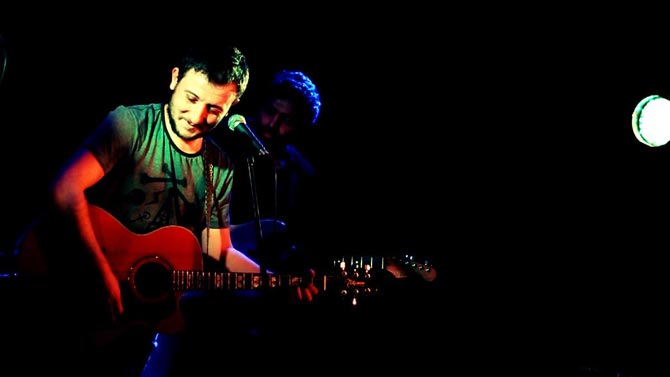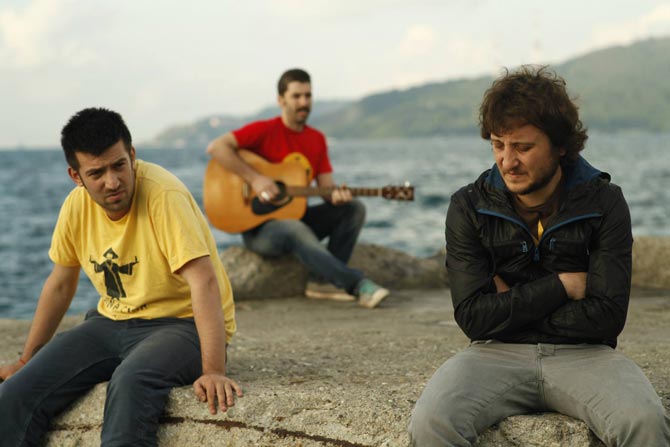
Melancholic Disharmony – Rockers with Roots in Hamshen Folk Blaze Their Own Musical Path
Meluses is an alternative rock group formed in Istanbul in 2009. While Hamshen folk music was the group's driving core, Meluses has ventured into new ground since.
The group has played numerous local gigs and has participated in various festivals.
Armenians have come to know the group through the Garmi and Ghadulik video clips that appeared on the internet some two years ago.
It’s not only the beautiful music that the group plays, but also the lyrics, that have garnered the attention of Armenian music lovers.
Despite the intricacies of the Hamshen dialect, listeners can make out various Armenian words and expressions. Those not familiar with the Hamshen culture inevitably ask, “Are they singing Armenian?”
In my conversation with the group, we didn’t get into the specifics of the linguistic identity and the questions that derive from the issue.

Kibar writes most of the songs for Meluses, meaning mer luys (our light).
This is the significance that we see in our music, and this is what we want to impart to people,” Kibar says. “When we say, ‘our light”, in reality we mean that we can be the light for all with our songs.”

Kibar is a native of Hopa, in Turkey’s Artvin province. It was in 2009 that five friends got together and decided to form a music group. The members are Koray Chelik (vocalist), Maghrouf Kibar (acoustic guitar, harmonica, vocals), Arif Kara (electric guitar), Erdem Shimshek (percussion), Gökhan Olke (bass guitar). Chelik is from Hopa, and the rest from Istanbul.
The group started by writing songs in the Hamshen dialect, and in Turkish. Hamshen folk songs are a significant part of their repertoire. Oftentimes, mostly at concerts, they present songs and melodies with no names.
Kibar says they sing and play all that which they see in life and the world. “Love, nature, longing. We also talk about things, through music, that we can’t express in words,” says Kibar.
The group won second prize at the 18th Roxy Festival, followed by TV appearances. It was then invited to appear on the Social Media program of Turkish state TV and the Garden in the Back program on the Turkish Hayat TV station. A half-hour documentary on the group was broadcast during the My Internal Voice program of Turkish state TV.

Maghrouf says that’s what’s important when entering competitions is that it affords the chance to get to know other musicians and to discuss various themes with specialists on the jury.
“For example, what do they think about music, what do they want to say, and what obstacles have they encountered?” Kibar asks, adding that music can’t be contested, neither can emotions. Music is directly felt.
The group issued its Ghadulik CD in 2015, including the songs Ghadulik, Garmi, Horte and Bobol.
Maghrouf says that Garmi and Ghadulik are part of a trilogy, and that the continuation, Tughulik, hasn’t been recorder yet.
Horte, Maghrouf says, is about a calf and the difficulties it faces in life and the love for its mother.
While Kibar says the group has been influences by many musicians and groups ranging from the West to the East, both in terms of place and style, one musician’s name stands out - Kazım Koyuncu.
A native from Hopa, Koyuncu, was a much beloved singer-songwriter in Turkey. He was also an environmental and cultural activist whose albums contain several songs in Turkish, Armenian, Homshetsi, Georgian and Megrelian, in addition to his native Laz. This creative musician is considered one of the founders of the movement to breathe new life into songs in the Hamshen dialect.

While many categorize Meluses as a folk rock, ethnic rock or Hamshen rock group, Maghrouf says the group can’t be labelled a rock spin-off.
“I hope that with the passage of time we will be able to find the Meluses style. Now, I think we can call it melancholic disharmony,” says Maghrouf.
One of the groups best loved songs is Garmi (Red).
During my first conversation with the band, finding out that people in Armenia were listening to their songs, Maghrouf was overjoyed. He hoped that one day the band could perform in Armenia.
“We’re not too familiar with Armenian music. But we know that it’s powerful and has deep roots,” said Maghrouf.
The group will soon record a new song, with an expanded group of musicians playing a variety of instruments.

In the meantime, Meluses keeps busy participating in various musical initiatives and giving charity concerts.
Photos: Meluses Facebook
 Videos
Videos Photos
Photos
Comments (4)
Write a comment